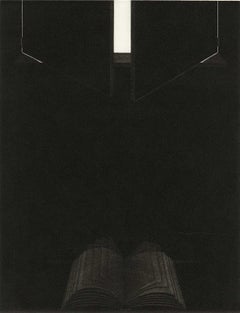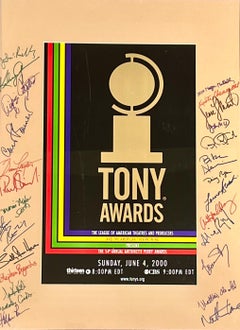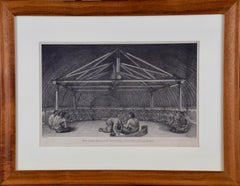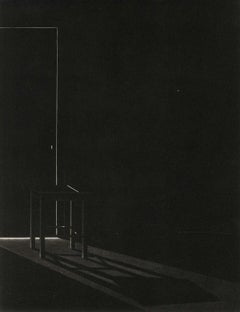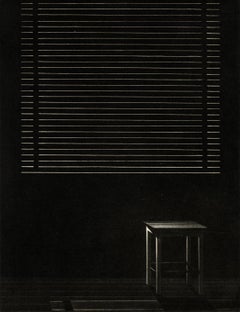Anne Dykmans Interior Prints
Belgian, b. 1952
Anne Dykmans is an established artist. Anne Dykmans was born in 1952. Artists born in the same year and of the same generation are Raúl Blisniuk, Peter Andersson, José Macaparana, Ricardo Cejudo Nogales, and Abolfazl Beytoei.
Further Biographical Context for Anne Dykmans
Born in 1952, Anne Dykmans was primarily influenced by the 1970s. The 1970s were a period of consolidation and development in the arts, most often characterised as a response to the central strains of the previous decade. Conceptual art developed as a key movement, and was in part an evolution of and response to minimalism. Land Art took the works of art into the extensive outdoors, taking creative production away from commodities and engaging with the earliest ideas of environmentalism. Process art combined elements of conceptualism with other formal reflections, creating esoteric and experimental bodies of work. Expressive figurative painting began to regain importance for the first time since the decline of Abstract Expressionism twenty years prior, especially in Germany where Gerhard Richter, Anselm Kiefer, Georg Baselitz became highly respected figures worldwide. A number of the artists who gained fame and successful in the 1960s remained dominant figures. For example, Andy Warhol branched out into film and magazine publishing, the first kind of cross cultural activity for a visual artist. This secured his reputation as a globally renowned celebrity in his own right. Towards the end of the decade, the emerging practices of graffiti and street art were beginning to gain attention in the fine art community. Artists like Keith Haring and Jean-Michel Basquiat were working in downtown Manhattan and guaranteeing that spray paint and tagging gained some acceptability as a fine art practice, a trend which would fully develop and dominate during the next decade.
to
2
Overall Width
to
Overall Height
to
1
8
108
76
32
30
2
2
1
1
1
1
1
1
1
1
2
2
2
Artist: Anne Dykmans
Fructidore (Fruit being carried is hard to distinguish from the woman's body)
By Anne Dykmans
Located in New Orleans, LA
In Anne Dykmans' "Fructidore", a well endowed woman uses her plaid apron to carry a bunch of fruit. Parts of her body clothed in plaid seem to suggest the same fruit she is carrying...
Category
1970s Modern Anne Dykmans Interior Prints
Materials
Mezzotint
Livre (An opening to the book of knowledge)
By Anne Dykmans
Located in New Orleans, LA
This image seems to capture the opening of knowledge through books. At the top of the imagemoors are opening revealing a sliver of light providing entree to yer massive book at the ...
Category
1970s Anne Dykmans Interior Prints
Materials
Mezzotint
Related Items
2000 Tony Awards Poster Signed by Celebrity Presenters Autographed Broadway
Located in New York, NY
2000 Tony Awards Poster Signed by Celebrity Presenters Autographed Broadway
Offered is the 2000 Tony Awards poster signed by the presenters, including: Matthew Broderick, Kristen Chenoweth, Kelsey Grammer, Jane Krakowski, Bernadette Peters, Ann Reinking...
Category
Early 2000s Performance Anne Dykmans Interior Prints
Materials
Paper, Color
"King of the Friendly Islands" (Tonga); Engraving from Captain Cook's 3rd Voyage
By John Webber
Located in Alamo, CA
"Poulaho, King of the Friendly Islands, Drinking Kava" is an engraving created by William Sharp (1749-1824), from a drawing by John Webber (1752-1793), who was the artist on Captain James Cook's 3rd and final voyage of discovery. It was published in the atlas of "A Voyage to the Pacific Ocean Undertaken by the Command of His Majesty, for Making Discoveries in the Northern Hemisphere", the official British Admirality sanctioned journal published upon completion of the voyage in London in 1784 by Strahan & Cadell.
Captain Cook visited Tonga on his 3rd voyage, which he named The Friendly Islands because of the warm welcome he and his crew received, unlike some of the other more hostile Pacific islands. The engraving depicts Cook and his men observed a kava ceremony at the village of Mu’a on Tongatapu. King Paulaho sits in the centre foreground, his back to the spectator with a man kneeling before him. The ceremonial mat depicted behind Paulaho indicates that nobody was allowed to sit behind him. The figure in the centre holds a single cup, referring to the Tongan custom of offering the cup to the king first. Kava is native to the islands of the South Pacific and was first described for English readers in 1768 by Captain James Cook. The kava root has been used for centuries as a central feature of ceremonies and celebrations because it was able to bring about a calming and pleasant social atmosphere. The root was crushed and processed into coconut milk to become the focal ceremonial beverage, simply referred to as kava.
This engraving is presented in a Koa wood frame and a white mat. Koa wood is legendary in Hawaii. There are occasional faint spots, but the print is otherwise in very good condition. This amazing Koa wood is native to Hawaii and it is known for the deep rich colors and varied grain pattern. Koa has an honored heritage in Hawaii and is highly revered and sacred. The word “koa” means “warrior” in Hawaiian. The warriors of King Kamehameha the Great, created canoes and weapons from a wood plentiful on the Big Island of Hawaii. This wood became synonymous with the warriors themselves, and it became known as koa.
There are three other engravings listed from the official journal of Captain Cook's 3rd voyage available that are presented in identical Koa wood frames and mats (LU117324682422, LU117324684052, LU117324684032). They would make a wonderful grouping for a display of 2, 3 or 4 prints. A discount is available for a grouping depending on the number of items included.
Captain Cook is remembered as one of the greatest explorers and navigators in history. His explorations included Australia, New Zealand and islands of the South Pacific and the northwest coast of North America. Hawaii was discovered by Captain Cook during this voyage. Hawaii was originally called The Sandwich Islands in honor of The Earl of Sandwich...
Category
1780s Realist Anne Dykmans Interior Prints
Materials
Engraving
$2,375
H 18.25 in W 23.5 in D 0.88 in
'Jesus and the Woman at the Well, ' by Amand-Durand, Engraving
By Armand Durand
Located in Oklahoma City, OK
This early 19th century framed 35" x 31" engraving by artist Amand-Durand depcits an etching of 'Jesus and the Woman at the Well,' after the Dutch master, Rembrandt van Rijn. This poignant Biblical story is depicted by Arman-Durand in Rembrandt style...
Category
Early 19th Century Old Masters Anne Dykmans Interior Prints
Materials
Engraving
$1,200 Sale Price
20% Off
H 30.5 in W 26.5 in D 1.5 in
Newspapers on the Table - Still Life Etching on Heavy Paper
Located in Soquel, CA
Newspapers on the Table - Still Life Etching on Heavy Paper, #20/150
Black and white etching by Darien Payne (American, b. 1951). This piece is a meticulously detailed depiction of ...
Category
1990s Photorealist Anne Dykmans Interior Prints
Materials
Archival Paper, Drypoint, Etching
$601 Sale Price
35% Off
H 16.5 in W 12.5 in D 1 in
MARILYN'S FLOWERS II, Signed Lithograph, Abstract Floral, Orange, Pink, Brown
By Peter Max
Located in Union City, NJ
Marilyn's Flowers II is an original hand drawn lithograph by Peter Max printed in an edition of 165, using traditional hand lithography techniques on archival paper, 100% acid free. Marilyn's Flowers II is a vibrant multicolor still life depicting an abstract floral arrangement of lush magenta pink blossoms, with warm red centers against a backdrop of brown and orange, with accents of blue, plum brown and black. The warm brown interior setting enhances the floating, freely drawn pop art cosmic flowers...
Category
1980s Pop Art Anne Dykmans Interior Prints
Materials
Lithograph
$1,850
H 21.5 in W 26 in
Bernard Sanders, Head of Girl
Located in New York, NY
For a print that's nearly one hundred years old it feels very contemporary.
Signed in pencil; titled in lower margin in pencil.
Category
Early 20th Century American Modern Anne Dykmans Interior Prints
Materials
Drypoint
Vin Rouge (Red Wine)
By Edmund Blampied
Located in Storrs, CT
1932. Drypoint. Appleby 167. 9 1/4 x 11 5/8 (sheet 11 3/8 x 17 15/16). Edition 100 #48. Mat line, well outside the image; otherwise excellent condition. A rich impression with drypo...
Category
1930s Modern Anne Dykmans Interior Prints
Materials
Drypoint
James Dobie "The New Will" Color Engraving After Walter Dendy Sadler c.1894
Located in San Francisco, CA
James Dobie "The New Will" Color Engraving After Walter Dendy Sadler c.1894
Original 19th century color engraving
Engraved by James Dobie after artwork b...
Category
Late 19th Century Anne Dykmans Interior Prints
Materials
Engraving
$375
H 23.5 in W 28 in D 2 in
Piranesi IV.
By Giovanni Battista Piranesi
Located in Slovak Republic, SK
Fine Art Print Hahnemuehle, editioned, Giovanni Battista Piranesi print in Verlag von AD Lehmann in Wien, end of the 19. century, SalamonArt certificate will be included.
Category
Late 18th Century Italian School Anne Dykmans Interior Prints
Materials
Archival Pigment
William Hogarth's "Analysis of Beauty": A Set of Two Framed 18th C. Engravings
By William Hogarth
Located in Alamo, CA
The two plates in this set were created utilizing both engraving and etching techniques by William Hogarth in 1753, originally as illustrations of his book on aesthetics, entitled "Analysis of Beauty". Due to their popularity, these plates were later published separately. The publication line in the lower right reads: "Designed, Engraved, and Publish'd by Wm. Hogarth, March 5th 1753, according to Act of Parliament." Hogarth's original copper plates were refurbished where needed by James Heath and engravings were republished in London in 1822 by Braddock, Cradock & Joy. This was the last time Hogarth's copper plates were used for printing. Most were melted during World War I for the construction of bombs.
These large folio sized "Analysis of Beauty" engravings are presented in antiqued gold-colored frames with double mats; the outer silk mats are light brown-colored and the inner mats are dark brown. Each frame measures 27.38" x 31.25" x 1.13". There is one tiny spot in the right margin of plate 1 and another in the lower margin; the latter could be from the printing process. The prints are otherwise in excellent condition.
The "Analysis of Beauty" series is in the collection of many major museums, including: The British Museum, The Metropolitan Museum of Art, The Tate Museum, The Chicago Art Institute and The Fine Arts Museums of San Francisco.
The first engraving (Plate 1) depicts a courtyard of statues which is filled with some of the most famous works of classical sculpture. The most important sculptures are surrounded by less impressive works. The Medicean Venus (#13) is in the center with a statue of Julius Caesar (#19) to the right, elevated on a pulley with a short, overdressed Brutus stands over the falling Caesar. The Apollo Belvedere (#12) is next. A judge stands to the right with his foot on a cherub (#16). Another crying cherub holds a gallows and wipes his tears with the judge's robe.
A sphinx (#21) and the drunken Silenus (#107) are below the Venus. Michaelangelo's torso (#54) and a statue of Antonius (#6) are seen in the foreground. The Farnese Hercules (#3) and a bust of another Hercules (#4) under two statuettes of Isis are also included in the scene.
The key to these objects is included in the form of a serpentine line winding around a cone (#26), Hogarth's "Line of Beauty". For Hogarth the winding line is an essential element of beauty in art. Hogarth's theory of beauty is communicated in this plate.
Plate 2 is thought to represent the Wanstead Assembly, with the Earl of Tynley and his household. It is an adaptation of a scene in the Happy Marriage series, which complements Hogarth's Marriage à la Mode...
Category
Mid-18th Century Old Masters Anne Dykmans Interior Prints
Materials
Engraving, Etching
$2,975
H 27.38 in W 31.25 in D 1.13 in
After Jonas Wood Jungle Kitchen Exhibit Poster Interiors & Landscapes Kordansky
By Jonas Wood
Located in Draper, UT
Stamped on the Verso of the print and in Mint Condition. From the David Kordansky Gallery show in 2017. Very rare poster that has been stored flat since purchase. One of his most ...
Category
2010s Contemporary Anne Dykmans Interior Prints
Materials
Lithograph
Original "This is what GOD give us ..." vintage poster WW1
Located in Spokane, WA
Original United States Food Administration vintage poster.
This is what GOD gives us
United States Food Administration. Artist A. Hendee.
This is
what GOD gives us
What are you giving
so that others may live?
Eat less
--wheat
--meat
--fats
--sugar
Send more to Europe or they will Stave.
A bounty of freshly harvested food is shown in the image. One of the more beautiful posters produced by the United States Food Administration for the war effort. World War 1 posters...
Category
1910s American Realist Anne Dykmans Interior Prints
Materials
Lithograph
$760 Sale Price
20% Off
H 29 in W 21.25 in D 0.05 in
Previously Available Items
Carbonrel
By Anne Dykmans
Located in New Orleans, LA
This impression was created in 1977 and is #20 out of edition of25
Anne Dykmans employs her superb command of engraving techniques, especially mezzotint, to create a special light w...
Category
1970s Contemporary Anne Dykmans Interior Prints
Materials
Mezzotint
Store I
By Anne Dykmans
Located in New Orleans, LA
In "Store I", Anne Dykmans depicts the stark outline of a very modest store interior.
Anne Dykmans employs her superb command of engraving techniques, especially mezzotint, to creat...
Category
1970s Modern Anne Dykmans Interior Prints
Materials
Mezzotint
Rue du Printemps (Shadows in house on Spring Street in Brussels)
By Anne Dykmans
Located in New Orleans, LA
Light pours through a sparsely furnished room in a space on Spring Street in Brussels creating stark shadows as it streaks through the bushes, blinds and the outline of a modern chai...
Category
1990s Contemporary Anne Dykmans Interior Prints
Materials
Mezzotint, Aquatint
Anne Dykmans interior prints for sale on 1stDibs.
Find a wide variety of authentic Anne Dykmans interior prints available for sale on 1stDibs. You can also browse by medium to find art by Anne Dykmans in engraving, mezzotint, aquatint and more. Much of the original work by this artist or collective was created during the 20th century and is mostly associated with the modern style. Not every interior allows for large Anne Dykmans interior prints, so small editions measuring 5 inches across are available. Customers who are interested in this artist might also find the work of Jukka Vanttinen, Yuji Hiratsuka, and Piero Cesaroni. Anne Dykmans interior prints prices can differ depending upon medium, time period and other attributes. On 1stDibs, the price for these items starts at $125 and tops out at $600, while the average work can sell for $315.

